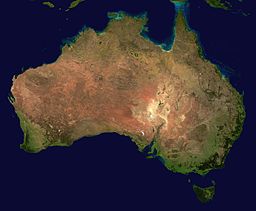By Allyson Gorsuch
 Have you ever spent any amount of time on an island? If you have, then you know that the local population is acutely aware of winds, tides, precipitation, humidity, and all other weather conditions in general. With little protection from a sizable land mass, the ocean and its resulting atmosphere become much more threatening. Although Australia is a continent in and of itself, it also is a large island.
Have you ever spent any amount of time on an island? If you have, then you know that the local population is acutely aware of winds, tides, precipitation, humidity, and all other weather conditions in general. With little protection from a sizable land mass, the ocean and its resulting atmosphere become much more threatening. Although Australia is a continent in and of itself, it also is a large island.
Although the rest of the world recognizes constantly increasing temperatures due to an apparent correlation between global warming, ozone depletion and the effects of a deteriorating Antarctic, Australia may be facing a far direr situation as the rainfall average lessens at an alarming rate.
The Australian released a report stating, “Rainfall has been below average across much of southwest and southeast Australia since 1997, whilst central and southern parts of the MDB have experienced below average rainfall since 2002. These long-term deficiencies have taken place against a background of well above average temperatures including Australia’s warmest decade on record.”
Climate warming affects the Antarctic in many ways, from slowly melting ice shelves to rising sea levels, but it is the changing of the Antarctic vortex that upsets the rainfall levels and results in the substantial drought seen in Australia today.
“The Antarctic polar vortex is a natural, continent-wide ‘tornado’ of 200 kilometers per hour, super-cold winds surrounding the ozone ‘hole’ from the stratosphere to the surface. It is created by the movement of the globe interacting with temperature differences between the pole and the rest of the Earth’s surface. The vortex delivers the winter rain-bearing westerly winds called the ‘Roaring Forties,’ which southern Australia relies on for its water supplies.” Unfortunately, the combination of global warming and the depletion of the ozone alter the regular vortex patterns, sending much of the precipitation south toward Antarctica rather than falling in Australia.
With the current urban reservoirs at minimal capacity, Australia faces an ominous future. Only through the diligent research will Australia stand a chance of understanding and, perhaps, overcoming this tremendous crisis.
Sources:
http://www.abc.net.au/science/news/enviro/EnviroRepublish_946924.htm
http://webdiary.com.au/cms/?q=node/2725

Comments are closed.